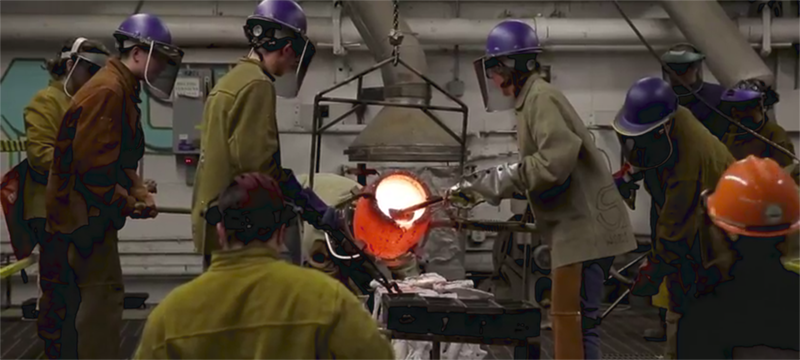[Majenta Strongheart] is one of the talented folks who works at the SupplyFrame Design Lab, home to dozens of Hackaday meetups, the Hackaday Superconference, and when the shop floor isn’t filled with chairs, is the place where tons of awesome projects are fabricated. [Majenta]’s role at the Design Lab is a Staff Designer, where she’s responsible for working the machines, and holds the distinction of being in the room when the SawStop kicked for the first time. Don’t fret: it was mirrored acrylic.
Among [Majenta]’s other duties at the Design Lab is on the social media front, showing off the capabilities of other design spaces around the country. Her first video in this series is from her alma mater, the Art Institute of Chicago. In this video, [Majenta] takes a look at the incredible fabrication facilities found here.
The tour begins in an exceptionally well-equipped wood shop kitted out with panel saws, spindle sanders, bandsaws, and not enough clamps. From there, the tour moves over to the metal shop and — unique for the city of Chicago — a forge. A long time ago, after Philadelphia and New York were the tech centers of America, and before the Bay Area was the tech center of America, Chicago made everything. The forge at the Art Institute of Chicago is the last remaining place in the city where metal casting takes place. This space was grandfathered in, and still remains a place where students can cast objects out of bronze and aluminum.
The Art Institute of Chicago is a very, very well equipped space full of enough tools to make anything you want. If you’re looking for some inspiration on what your basement, garage, or local hackerspace should look like, you need only look at [Majenta]’s tour. You can check out the entire video below.
















Wow! Those are some serious impressive facilities! I’ve worked in factories that didn’t have shops that well equipped!
Art Schools often have impressive workshops. I work at a “little” school in France, and we have a metal shop, wood shop, silk screening shop, ceramics shop, lots of different little tools, sound studio, lots of cameras / microphones / etc.. and, the part I’m responsible of, a kind of FabLab with 3D printers, laser cutter, CNC router, electronics, etc… We regularly work with concrete, plaster, resins and all other kind of weird stuff (today, just before leaving work, we were talking with a student about ways to do some kind of organ preservation like plastination or embalming, but on the cheap without harmful and hard to get chemicals)
The philosophy is that you never know what you’ll need, and if money allows it, we always try to get new tools to work on new techniques. As soon as the HTC Vive was released, we got one, and we’re starting to see students make some nice Art in VR. By Art with a capital A, I don’t mean drawing with tiltbrush, but questioning the implications of technology on society (what does it mean to be physically in a space if your senses can’t distinguish between the VR world and the real world ?), stuff like that.
So yeah, art schools are cool. If I knew that a dozen years earlier, I would have tried to enter one instead of doing webdesign :)
And just to be clear : our students don’t really get a technical formation, just enough to make their projects. They are not welders, they can stick metal together just well enough to make a sculpture or a structure that don’t see too much load. They are not programmers or 3D modelers, just enough to get an arduino to do their bidding or have an object 3D printed.
Thanks for the info. It can only be a good thing to give students access to such an excellent variety of good tools and the knowledge of how to use them.
You didn’t mention glass blowing, do they have that?
We don’t have that here, but some schools do. I know of schools with huge kilns, a foundry, or an offset press. It mostly depends on the professors and technicians working there and their medium of choice.
Glassblowing requires some serious dedicated equipment. In particular, the oven that melts the glass has to be run 24/365, it’s not something that can be fired up when you need to use it because of the high temperature and the time required for the glass to liquefy. Glassblowing with simple rods and tubes is a different matter, a proper torch is all that is needed for small items.
Getting the “feel” of the glass is the epitome of “if you don’t use it, you lose it”.. When I was in grad school I spoke to one of the glassblowers (chemistry) who said that he could tell a difference in his work on Friday vs. Monday (two days off). After I got tenure I taught a rudimentary scientific glassblowing class several times—straight joins, t-joins, bends, that sort of thing. Each time I taught, I had to get out the equipment and practice some hours to bring myself back up to snuff, even with simple stuff.
“…when the SawStop kicked for the first time. Don’t fret: it was mirrored acrylic.”
Something wrong with cutting mirrored acrylic on SawStop saws? I don’t understand. Is there something conductive in the material?
BTW, pretty cool facility. I didn’t see it, I wonder what the welding lab looks like. I saw the CNC plasma cutter and some oxyacetylene cutting tables in the background.
The mirror film on the acrylic is probably aluminum, so yes conductive
The word you’re looking for is foundry, you cast metal in a foundry. A forge is something else altogether.
Correct Steve. And there are at least four other foundries in Chicago that cast metal.